Introduction
Our parish was founded as Saint Jean Baptiste in 1873 (10 years before the founding of the Manchester Diocese) for a majority population of French-Canadian immigrants. It is still affectionately known by many as St. Jean's. In our 150+ years of history, we have weathered many storms (including our church being literally struck by lightning) and endured many changes (like going from French-speaking to English-speaking). And still, our noble wooden church stands gracefully at the crest of Main Street, inviting all who enter through our doors into the Fullness of Life in Christ. Grateful for the faith-filled tradition of our forebears and building upon our rich history, our parish is committed to providing the Sacraments and needed ministry to many more generations to come. As you read the vibrant history of our Suncook parish, please keep in mind that we are currently living the future history of St. John the Baptist – join us!
"Behold, the Lamb of God who takes away the sin of the world!" – St. John the Baptist, John 1:29
The Spirit of Christ Illustrated
In the Beginning
Until the Civil War, the area towns of Suncook had retained their agricultural character synonymous with New England of the era. In this period, a new economic industrial base was dawning, one 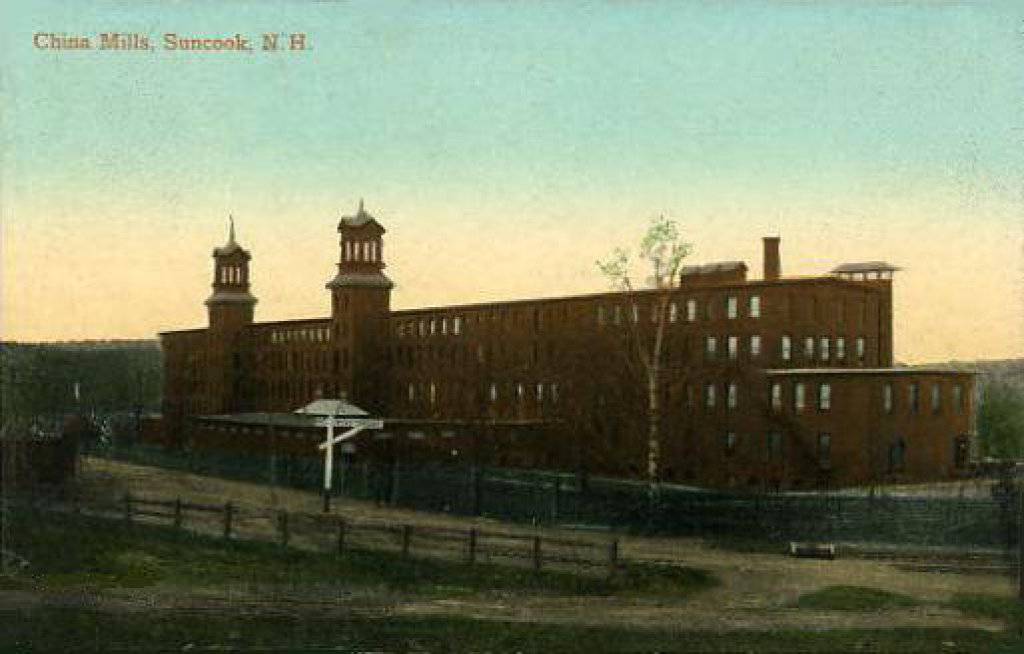 that was to revolutionize the area and attract many new residents. The construction of the Suncook Valley Railroad in 1850 was a strong initial factor in these developments. It led to the growth of the textile industry. Subsequently the Pembroke Mills were completed in 1855, the Webster Mill in 1860, and the China Mill in 1868. Concurrent with this construction, numerous brickyards dotted the area.
that was to revolutionize the area and attract many new residents. The construction of the Suncook Valley Railroad in 1850 was a strong initial factor in these developments. It led to the growth of the textile industry. Subsequently the Pembroke Mills were completed in 1855, the Webster Mill in 1860, and the China Mill in 1868. Concurrent with this construction, numerous brickyards dotted the area.
This industrial expansion generated a wave of immigration. The newcomers were to arrive in a community with a deep Protestant Christian tradition. In the latter half of the nineteenth century, the Christians of the area were well represented by three viable church groups – Congregational, Methodist, and Baptist.
With the building of the railroad, many Irish immigrant workers had settled in the area. The textile industry in its turn attracted a large number of French-Canadians. These new residents were of the Catholic Faith, but did not have a church of their own. In 1861, Suncook was designated a mission of St. John the Evangelist, Concord. The Rev. John E. Barry regularly visited the area celebrating Mass in various homes.
By 1870, the faithful of New Hampshire requested the formation of a parish to their Bishop, Most Rev. David W. Bacon of Portland Maine. Their petition was received with such acknowledged need that, in 1871, when the Rev. J Augustin Chevalier arrived in the diocese to form a French-speaking parish, he was given the choice among Manchester, Nashua, or Suncook. He chose St. Augustin, Manchester. In the same year, Rev. Louis Millette founded St. Louis-de-Gonzague, Nashua.
It was early 1873 when an Oblate missionary from Manitoba, the Rev. Jean-Baptiste Richer, was appointed to establish a parish in Suncook. The parish was to take its name from the patron saint of the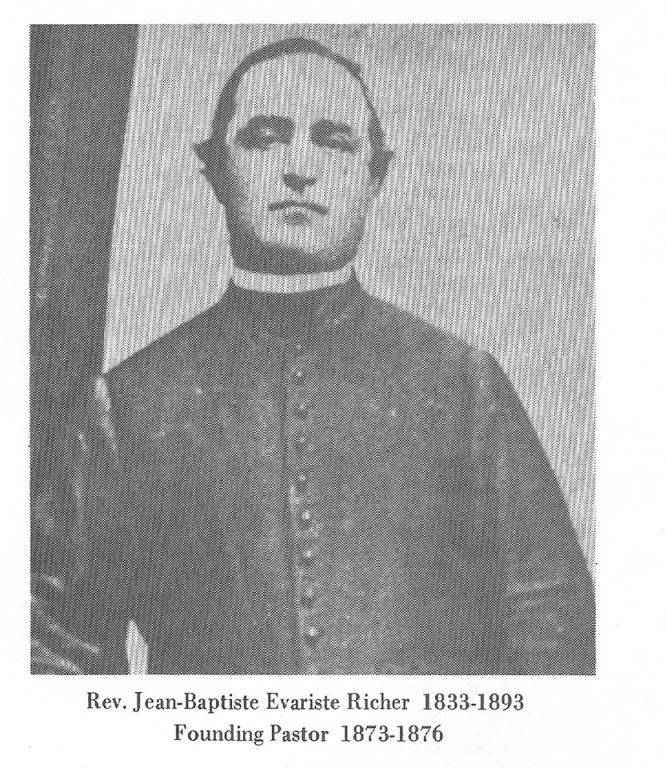 founding priest – St. John the Baptist, in french, St. Jean Baptiste. It was to cover the territory of Allenstown, Pembroke, Epsom, Hooksett and Pittsfield. Eventually Hooksett and Pittsfield were to become their own parishes.
founding priest – St. John the Baptist, in french, St. Jean Baptiste. It was to cover the territory of Allenstown, Pembroke, Epsom, Hooksett and Pittsfield. Eventually Hooksett and Pittsfield were to become their own parishes.
The first parish records date back to January 3, 1873 with the baptismal entry of Honoré Vien – son of Trefflé Vien and Eleonore Normandin. No census records exist for that year, but, during the first year, 83 baptisms and 29 marriages are registered. It is assumed that the faithful numbered nearly a thousand with a majority being French-speaking and the rest being of Irish heritage.
With the task of building a church, land was acquired from the China Manufacturing Company on April 9, 1873. The property measured a hundred feet along Hooksett Road (today Main Street) and two hundred feet along the tracks of the Suncook Valley Railroad (north side of the church land). The deed stipulated that a church and other parochial buildings could be built on the property, but never a cemetery.
On this site, a modest wood-frame church was constructed. In the fall of the year, Bishop Bacon blessed the church. Remodeled many times through the years, the church has remained to this day as our house of worship.
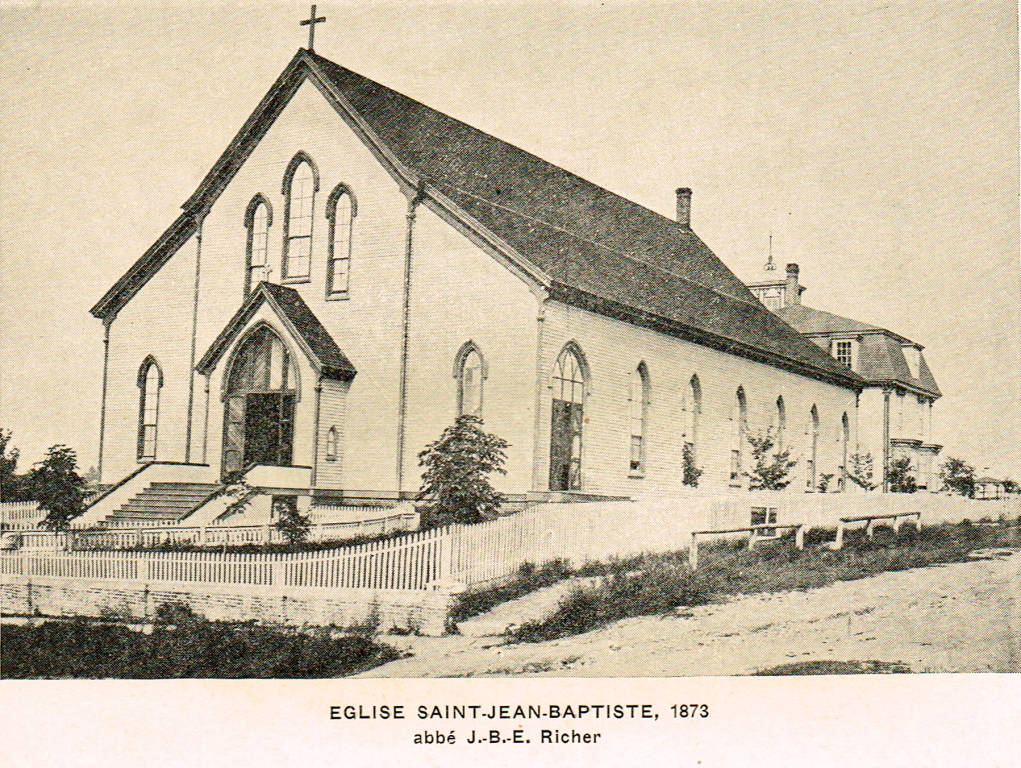
The need of a cemetery was satisfied on May 20, 1873. Purchased from William Haseline for $480.75, the land was situated on the northern side of a certain road called the River Road, running easterly from the Chester Turnpike at a point about on mile distant from the center of Suncook. Reflecting on the modest means of the faithful, an unmarked section was reserved to bury those unable to purchase burial lots. Families, who did purchase burial sites, were responsible for its upkeep. This practice was to continue without change until 1957.
The beginnings of the new parish barely completed, Father Richer was transferred to a parish in Maine. On November 23, 1876, the Rev. Nazaire N. Hardy arrived from Troy, NY as our second pastor. His stay in Suncook was relatively brief. He carried out the completion of the work on the rectory and, in 1881, retired to Saint-Roch-sur-Richelieu in Canada.
In February of that year, the Rev. Isidore J.C. Davignon assumed the direction of St. John the Baptist.
It fell upon Fr. Davignon to continue the forming of our parish. His main goal was to continue to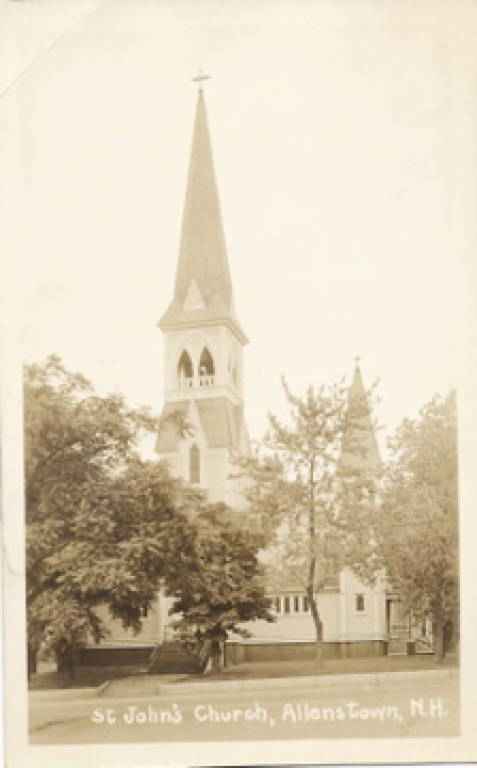 remodel and enlarge the church, but within two months, on April 19, 1881, he purchased the neighboring Cofran property for the purpose of establishing a school. A steeple and two adjoining belfries were added to our church, creating a new façade. New stained glass windows were installed and the donor’s names inscribed on each. They include: Louis Dubé, Z. Longre, John Welch, John Cyr, Telesphore Hamel, Dr. Agustin Brien, Victor Guilbert, Joseph St. Germain, Pierre Michaud, Enfants de Marie, M.C. Pinette, Joseph Fleury, Joseph Delisle, H.D. McDougall, Mederic Perrault, and A. Provencal.
remodel and enlarge the church, but within two months, on April 19, 1881, he purchased the neighboring Cofran property for the purpose of establishing a school. A steeple and two adjoining belfries were added to our church, creating a new façade. New stained glass windows were installed and the donor’s names inscribed on each. They include: Louis Dubé, Z. Longre, John Welch, John Cyr, Telesphore Hamel, Dr. Agustin Brien, Victor Guilbert, Joseph St. Germain, Pierre Michaud, Enfants de Marie, M.C. Pinette, Joseph Fleury, Joseph Delisle, H.D. McDougall, Mederic Perrault, and A. Provencal.
Then on July 14, 1884, our 1700 pound bell was installed, a product of the McShane Foundry of Baltimore. On April 19, 1885, with the restoration finished, the new Bishop of Manchester, the Most Rev. Denis M. Bradley, was invited to bless the renovated church.
As founder of the parochial school, it was on February 25, 1888, that Father Davignon welcomed the Sisters of Holy Cross and Seven Dolors. Within a week of their arrival, classes were opened with three sisters and 192 students.
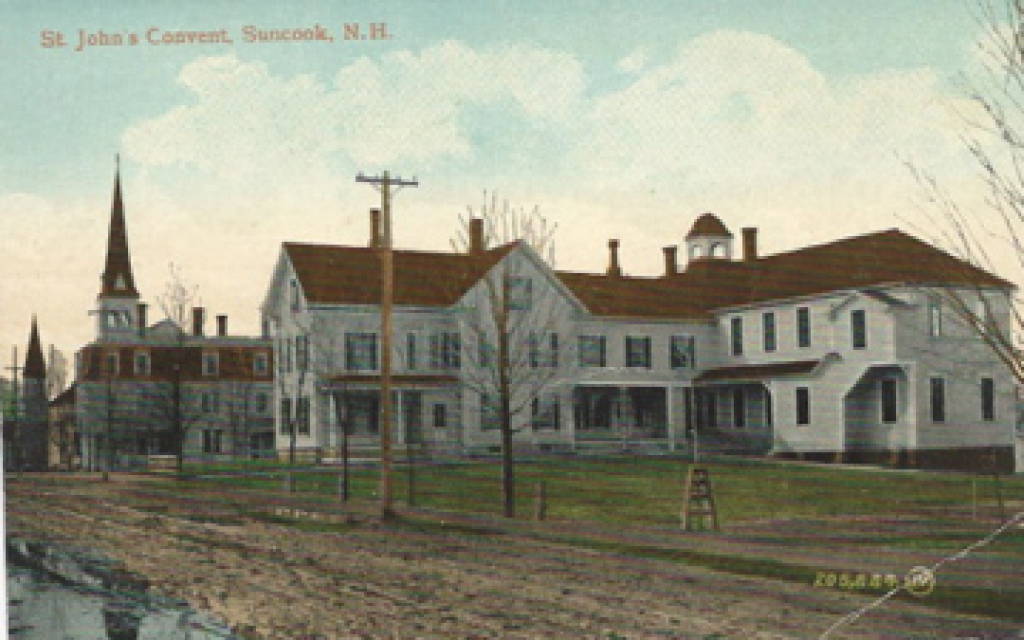
Interest in his parishioners extended beyond his basic ministry, and Father Davignon was keen to exhort the cultural heritage of his flock. He was instrumental in organizing the “Cercle Dramatique et Littéraire”, a society that was to flourish for nearly 75 years. It also became the custom to celebrate La Fête de Saint Jean-Baptiste, commonly called "La Saint Jean Baptiste", on June 24th of each year with a theatrical production and parade.
In 1895, Father Davignon was called as pastor of St. Georges, Manchester. On January 2nd of that year, the Rev. Onesime J. Dèsrosiers assumed his duties as our fourth pastor and would remain in Suncook for twelve years, devoting his zeal to the burgeoning needs of the faithful. Because of this, it was necessary to enlarge the school – not an easy task, as many of the parishioners were becoming permanent residents with only modest means. As was customary with the times, people were apt to work six days a week from six in the morning to six at night, and yet parish activities were maintained. During this time, the “Societé des Dames de Sainte-Anne” was established – an organization that is still active in the parish today.
On April 27, 1909, the Rev. Noel-Joseph Plante replaced Fr. Desrosiers who was assigned to St. Martin parish in Somersworth. Fr. Plante had the distinction of being the first Canadian specifically ordained for the Diocese of Manchester. He was also to have the longest pastorate in Suncook, spanning 23 years.
Shortly after his arrival Fr. Plante had a combination convent-school built for the increased student numbers and to house the sisters properly. It was completed in 1910.
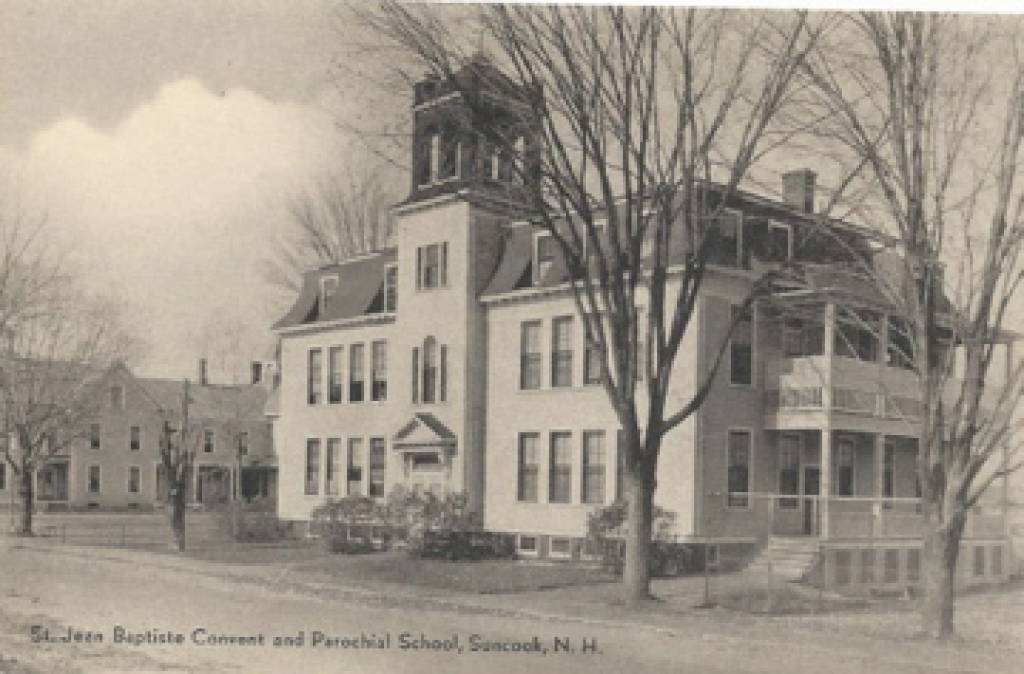
In 1915, the parish census recorded 480 families and that same year the parish of Suncook celebrated its feast day. Heading the parade was the Suncook Band, a musical group that would be instrumental in the success of the annual lawn parties that were inaugurated during this period.
Unfortunately a period of austerity was to plague the parish. Due to the post World War I economic situation and sporadic closing of the Mills, strikes and lay-offs became the norm. A large number of families would leave, forced to find employment in other New England centers. Those who remained were often hard-pressed and it was not uncommon to seek solace at the rectory.
Consequently, at his death on January 21, 1930, Father Plante was held in such esteem, that on the day of his funeral, all business enterprises of the town ceased operations.
1933 – 1973
Our sixth pastor, the Rev. Louis-Philippe Routhier was appointed on September 30, 1930. One of his early accomplishments was the renovation of the church. At a cost of approximately $15,000, the sanctuary was redone, choir stalls were erected, the altar was simplified, and a new sanctuary lamp was hung. In honor of the occasion, Bishop John B. Peterson donated the wooden crucifix, which was sculptured in Bavaria. Other donations from parishioners were the tabernacle, from Mr. & Mrs. Wilfred Menard, the statue of the Sacred Heart, from Mr. Henri Auger Sr., and the sanctuary lamp from a group of families.
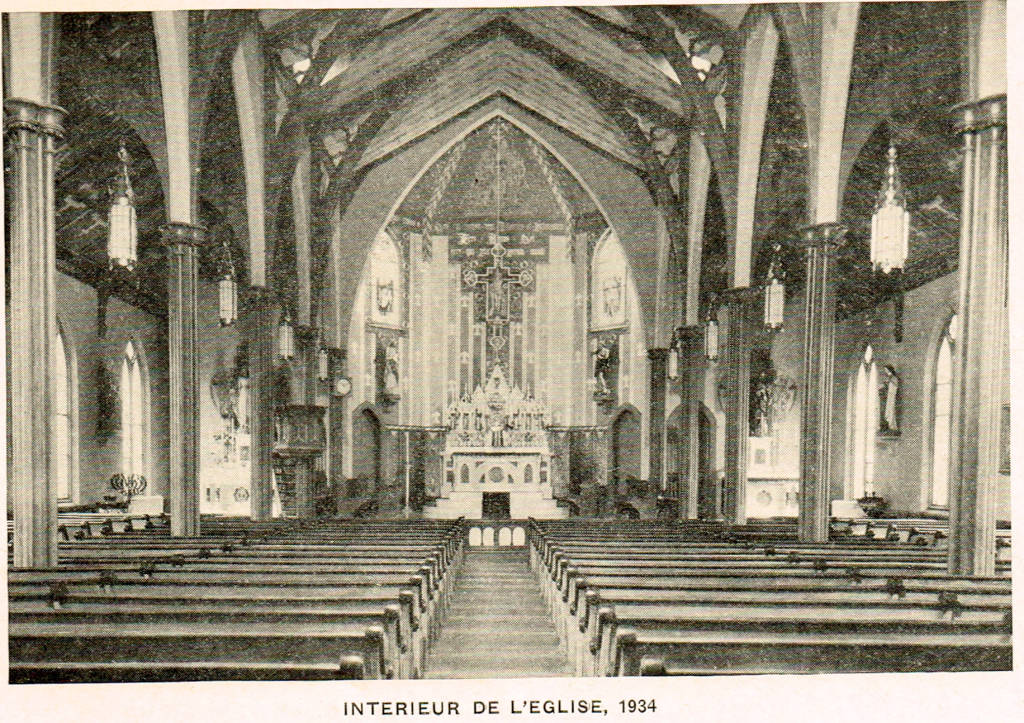
The blessing of our renovated church by the Bishop was held on May 23, 1934. This coincided with the ordination of a son of our parish – Rev. Lionel Parenteau.
In his annual report of 1935, Father Routhier announced the number of families was 741, school enrollment was 526 and the parish debt was only $3,400 – a debt that would be completely cleared by August 1936. On the 15th of December 1935, a piece of land on River Road was purchased from Mr. Frank Fleury for the purpose of a new cemetery.
Besides his administrative ability, Father Routhier was greatly interested in the activities of his flock. Recognition was given to young adults with the organization of the JOC, “Jeunesse Ouvrière Catholique”. A room was created in the basement of the convent for gatherings of this youth group and a skating rink developed next to the convent. With a need of a men’s group, the “ Ligue du Sacré-Coeur” was organized in 1937.
May 30, 1940 marked the date Father Routhier was transferred to the pastorate of St. Marie’s in Manchester. His replacement was the Rev. David J. Caron, who passed away on July 18, 1941, serving Suncook for barely a year. On June 24, 1940, the last celebration of “La Saint Jean-Baptiste" was held. Sponsored on a state wide basis, nearly 15,000 attended the parade, picnics, and fireworks.
On November 3, 1941, the Rev. Elzear N. Durette, our eighth pastor, assumed his pastorate in Suncook, one marred by austerity. With the outbreak of World War II, the young men of our parish were scattered around the globe in the service of their country. Rationing was a way of life and he had to administer the parish with receipts barley equal to the depression years.
Due to deteriorating health, Father Durette went to the “Cenacle Saint-Pierre à La Pointe du Lac” in 1950, with the hope of recovery. But by June 1953, he was forced to tender his resignation.
In the interim, the Rev. Arthur J Lesmerises assumed the reins of our parish as administrator for 3 years. It was during this time that the idea of a gymnasium-parochial center was conceived. A method of financing this enterprise was formulated and BINGO was born. Empty spaces in the old school were expropriated and weekly sessions were held there with great success.
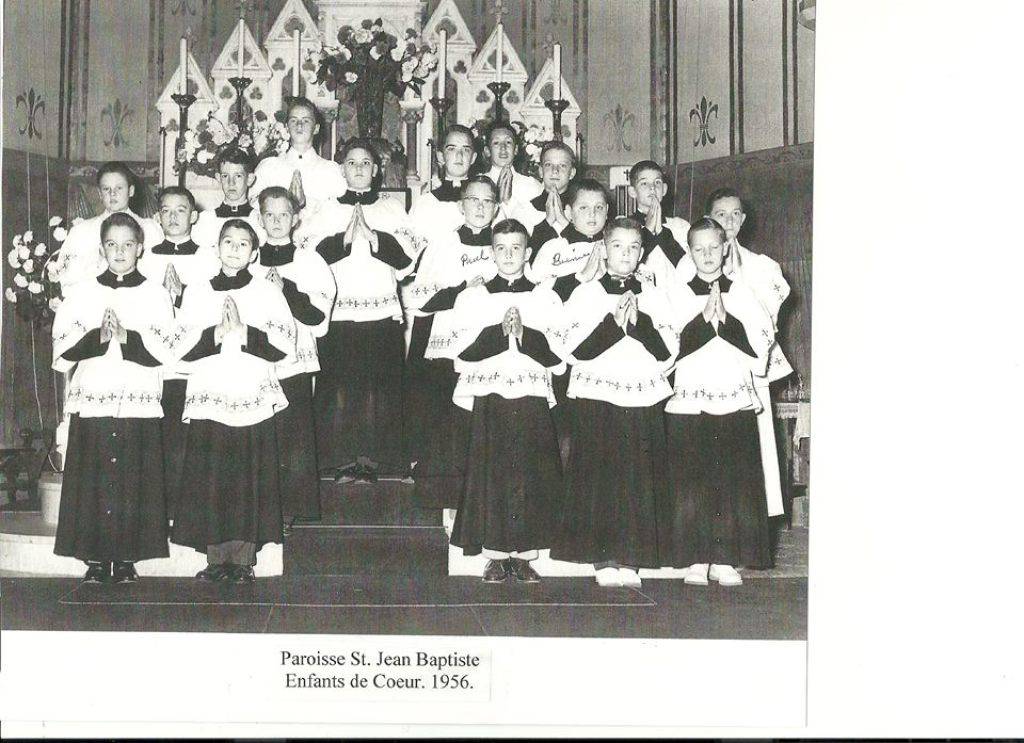 The Rev. Adrien Verrette was welcomed as our 9th pastor on June 26, 1953. Right away it became evident that the parish buildings needed to be refreshed. Accordingly, the rectory was remodeled to improve the living quarters and to provide appropriate space for the parish office.
The Rev. Adrien Verrette was welcomed as our 9th pastor on June 26, 1953. Right away it became evident that the parish buildings needed to be refreshed. Accordingly, the rectory was remodeled to improve the living quarters and to provide appropriate space for the parish office.
In that autumn, the construction of a parish social center was started. Financed initially with a subscription of $63,000, the cost rose to more than $100,000 before completion. But its value as a social center could not be minimized. For, shortly before Father Verrette’s arrival, the local textile mill, then owned by Textron, closed its operations. Many parishioners were no longer locally employed and a center for reinforcing the bonds of community was sorely needed for a populace becoming suburbanite. The center was used as a true social center, with many religious, school, and cultural functions.
Keenly interested in the solidarity of the Christian family and necessity for its economic well being, Father Verrette was instrumental in sponsoring a Credit Union for his parishioners in 1955. Being an astute administrator, Father Verrette was able to rejuvenate every section of the parish. Our church interior was refreshed with new colors, the sanctuary was simplified and embellished, and the exterior of the parish buildings were all painted white. A parking lot on the north side of the church was constructed. A monument was erected on the rectory lawn in honor of the men who served their country in the armed services.
Additionally, our cemetery underwent extensive improvements. An altar was erected, an imposing entrance constructed, the drives paved, the vault enlarged, and the grass cultivated. Then perpetual care was initiated relieving families of the burden of maintaining their own plots. With the labors done, the custom of commemorative Masses on Memorial Day was inaugurated - a custom that continues today.
In May of 1960, Father Verrette was appointed pastor of St. George parish, Manchester, to be replaced by the Rev. F. Eugene Belanger. “The Altar Guild”, a viable ladies organization, was founded by Fr. Belanger to acknowledge the English speaking ladies of our parish. Father Belanger passed away unexpectedly on December 16, 1963.
Our 11th pastor, the Rev. Ernest Gagnon, was named to Suncook on February 20, 1964. In retrospect, it seems that Fr. Gagnon’s pastorate was one of change. Because of the changes initiated by the Second Vatican Council, liturgical changes were implemented with ardor. In keeping with directives, a simple altar was placed in front of the sanctuary permitting the priest to face the congregation in the celebration of the Mass. By use of the vernacular (French and English) hymn singing, and lectors, a greater participation of the laity was encouraged.
The zeal of our pastor was well recognized by his superiors and on October 2, 1965, he was elevated to the rank of Domestic Prelate. Msgr. Gagnon has the distinction of being the only pastor of Suncook so honored. Our parishioners celebrated the occasion with a festive dinner reception in the parish hall.
Another pressing need that precluded change was the replacement of the school building. This building had reached such a state where further renovations were inappropriate. With able assistance of an “architect in residence”, our associate pastor Rev. Gerald Chalifour, the construction project started in 1967. Not only geared to daily instructional use, it was also adaptable for various religious educational needs. Erected at a cost of nearly $200,000, it replaced the old school and, in September, classes were inaugurated in the new building.
With all school facilities now concentrated in one building, the convent was converted for sole use of the Sisters. After 80 years, the nuns no longer needed to share their quarters with students and were finally able to vacate their attic dormitory.
This period also reflected changes in parish management. In 1969, resulting from the Second Vatican council, the laity was encouraged to participate in parish administration with the election of the Parish Council and a School Board.
Plagued by bouts of illness, Msgr. Gagnon tendered his resignation as pastor February 3, 1971, and assumed the chaplaincy of St. Charles Orphanage, Rochester, where he could still perform a ministry rather than retire as expected for a priest of his age.
Our 12th pastor, the Rev. Roland Veillette continued the renovations of the church properties. The sanctuary was enlarged and the communion rail and choir stalls were removed. Not only were the changes meant to be more pleasing to the eye, but also intended to adapt to current liturgical services. The cost of these renovations were underwritten solely by generous donations of our parishioners. The completion of these labors coincided with the ordination of a son of our parish, Paul Bouchard (now Msgr.) in July 1972.
In 1973, our parish celebrated its centennial anniversary! There was much thanksgiving and festivity, including the publication of the history that you have been reading (with minor edits). And our thanksgiving continues as we reach into a new millennium…
The Next 100 Years
We are now 50 years into our second century and are currently working on a history up to the present time. (We're looking for volunteers to help us find facts and pictures — if you're interested, please send an email to StJBOnline@Gmail.com .) And so a new chapter begins…
In just the last several years, we received a much-needed new roof (kiddie pools were being used in the choir loft to catch the leaks), replaced our boiler, repaired the steps, and renovated the sanctuary.
In November 2020 and June 2021, we mourned, respectively, the passing of our administrator, Fr. Adrien Longchamps, and the passing of our retired priest in residence, Fr. John Finnigan. Our good friend Fr. Edmund Crowley of Holy Rosary in Hooksett assisted us in the interim until, in July 2021, we gratefully and joyfully welcomed Fr. Michael Gendron (pastor of St. Peter's in Auburn) as our pastor and newly-ordained Fr. David Gagnon as our parochial vicar.
Sadly, due to broken pipes and disuse, our old convent building was condemned and had to be torn down. Although the building no longer exists, the memories endure as well as the beautiful influence of the Sisters who made it their home for decades. After Fr. David moved on to his own parish in 2022, Fr. Michael remained our pastor and we welcomed Parochial Vicar Fr. Roarke "Rory" Traynor, who introduced an All Souls Day candlelight possession in our cemetery and optional kneelers for receiving Holy Communion, along with other reverent touches.
In June of 2025 we had to say a sad good-bye to Fr. Rory but we welcomed newly ordained Fr. Andre Nadeau as our parochial vicar.
Let us leave you with these words of Pope St. John Paul II written as the Church celebrated the new millennium:
"Duc in altum! [Put out into the deep!] These words ring out for us today, and they invite us to remember the past with gratitude, to live the present with enthusiasm and to look forward to the future with confidence: "Jesus Christ is the same yesterday and today and for ever" (Heb 13:8)." "
